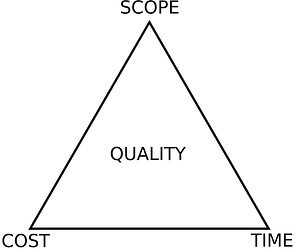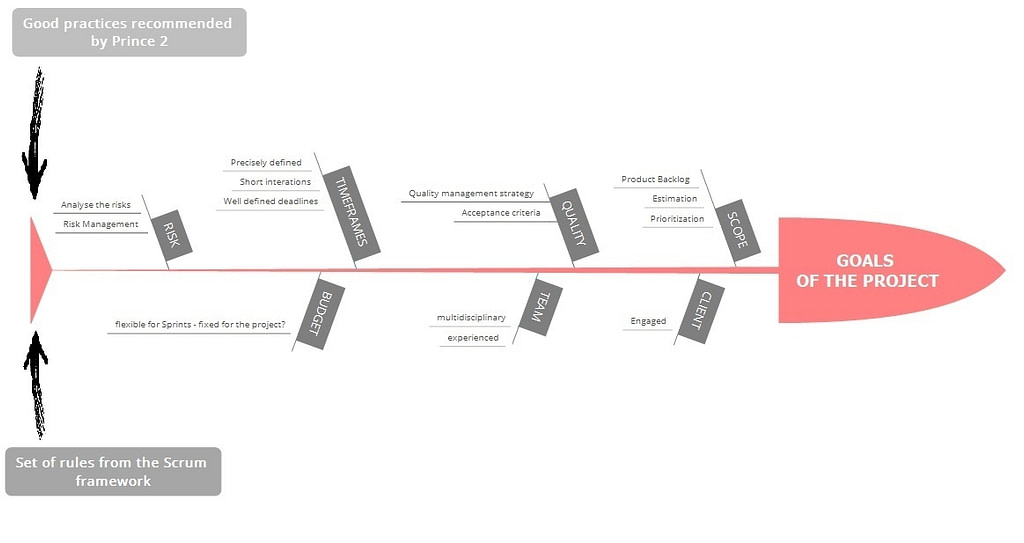New methodologies have always been developed to challenge traditional models. The Agile Manifesto, for instance, was developed as a form of opposition to rigid regulations and rules. Those who fancy agile methods of project management (like Scrum) fight against those who cannot imagine a project without traditional project management methods like the Waterfall. But the rise of hybrid methodologies can change this order for good.
The idea which stands behind the rise of hybrid methodologies relies on the assumption that there can be synergy in combining aspects of new and traditional work methods. The hybrid methodologies were designed with acceptance for the fluidity of projects. They allow a more nimble and nuanced approach to work. At the same time, they provide good risk management practices well known from the traditional approach.
Like every new approach, they both have supporters and opponents. The first ones promote hybrid methodologies for adaptability and believe that they can be a perfect solution, especially for projects with multiple changes. The second group claim that a hybrid methodology is unknown and without a clear understanding of the hybrid model, there’s a risk that it will make a mess in the project and bring no benefits. In this article, I will try to convince you that hybrid methodologies give you the flexibility to pivot in a project and that you can use different methods for different aspects of the project.
Learn how to choose the best IT outsourcing company
We live in an era of hybrid solutions
Whether we like or not, hybrid methodologies are here to stay, not just in the car industry. According to the ESI International Top 10 Project Management Trends research, “New, innovative business models and technologies will force project managers to adapt. With many industries undergoing rapid changes, project management methods that allow for accelerated development and rapid learning will become critical to serving the business”. Project management is not a static industry and project managers who are not willing to stay abreast of new developments in the profession run the risk of being left behind.
Even if you think that you will not need hybrid models in your projects, it is important to keep up with all the existing methods and frameworks. Every Project Manager knows that in this job, you need to be up to date with the latest news, and not just technical news. Remember that the project management area is changing as rapidly as the whole IT sector. When you know the existing and latest solutions, you will be able to combine the advantages of them and provide optimum guidance and management framework for your projects.
If you only worked with one methodology, try to get some knowledge about others. You can base on the experience of other project managers from your company or the community. Try to focus on the primary assumptions and check how the methodologies work in real projects. Remember that there is a huge gap between theory and practice and that the key of hybrid models is to develop your own rules, not to copy another existing, rigid methodology. Get knowledge about solutions that already exist but, at the same time, create your own, better rules.
How to improve your project management methods? Start with a thorough analysis of the project
The main goal of project management is to identify the right steps and implement them in the unique project. After gathering knowledge about existing methodologies, you should analyze your project precisely. You need to consider the scale of the project – and by scale, I mean total financial resources available, a number of team members involved, number and size of deliverables to be produced, the complexity of deliverables to be produced, time frames involved in delivery, and all contractors who are involved in the project. Such analysis will allow you to choose the best possible solutions for your project.
As every project manager knows, there is a project management triangle.

We should start from analyzing the first part of the triangle which is the scope. If you understand the scope, you will be able to choose methods of managing project and risk. In order to do that, you should analyze the work and resources that go into the creation of the product or service. You need to define the boundaries, outline the objectives of the project and the goals that you need to meet to achieve a satisfactory result. Once it’s ready, the analysis of the scope will give you a wider overview of what techniques you need.
The next part of the triangle is a schedule. The schedule of the project defines what work needs to be done, which resources of the organization will be used and under what time frame. The project schedule should reflect all of the work associated with delivering the project on time. Timeframes help us manage the project by setting certain rules of the game. When you have very rigid deadlines, you have to choose different techniques than those that could be chosen with more flexible frames.
The last, but not least, part of our triangle is the budget. Budgeting is the essential part of making project management decisions. Without the well-planned budget, projects can fall apart and be left incomplete. Budgets can be fixed or flexible, depending on the industry in which the project is implemented, and based on the availability of additional income sources. Therefore, we should choose the methodology that is consistent with our type of budget.
Code isn’t the most important part of your project – people are
You have to remember that the most important part of your project is your team and all the people involved. It doesn’t matter if you work in Scrum or Prince2 – people should always be on the top. And this is another basic point in the hybrid model planning: you should analyze the experience of your team. When you have to choose how to manage the project, you need to know what kind of team you will work with. People are always the most important factor. You can have the best technology and the best rules and techniques, but without the understanding and involvement of the team, you will never get to a win-win situation.
The client’s role in project management
The key goal of project implementation is to complete it within the established time and budget, with a high degree of customer satisfaction. A client’s role in project development and implementation is crucial to the success of the project. The first questions you should ask yourself are: How much time does your client have and to what extent does he or she want to engage? For example, if you choose some Scrum frames, you have to involve your client. You will need to be sure that the client wants to monitor the product backlog.
Opposites attract! The fuel for the hybrid
After all the analysis and reviews, you can start the process of choosing which part of which methodology you will need. Remember that even if two methodologies, let’s say Scrum and Prince 2, are absolutely different, the artifacts of both can perfectly complement each other.

To sum it up, I would recommend you choose the framework and assumptions that best fit into the ideas of your projects. Don’t be afraid of experimenting! The main advantage of hybrid models is the flexibility and adaptability to the particular project. If you think about it, hybrid methods seem to be more agile than Agile.
Last but not least: do not be afraid to create new management models! Project management is very dynamic and project managers should also be creative and courageous in their actions. Don’t be afraid of changes, because there are only three things that we can be sure of: death, taxes, and CHANGES.
